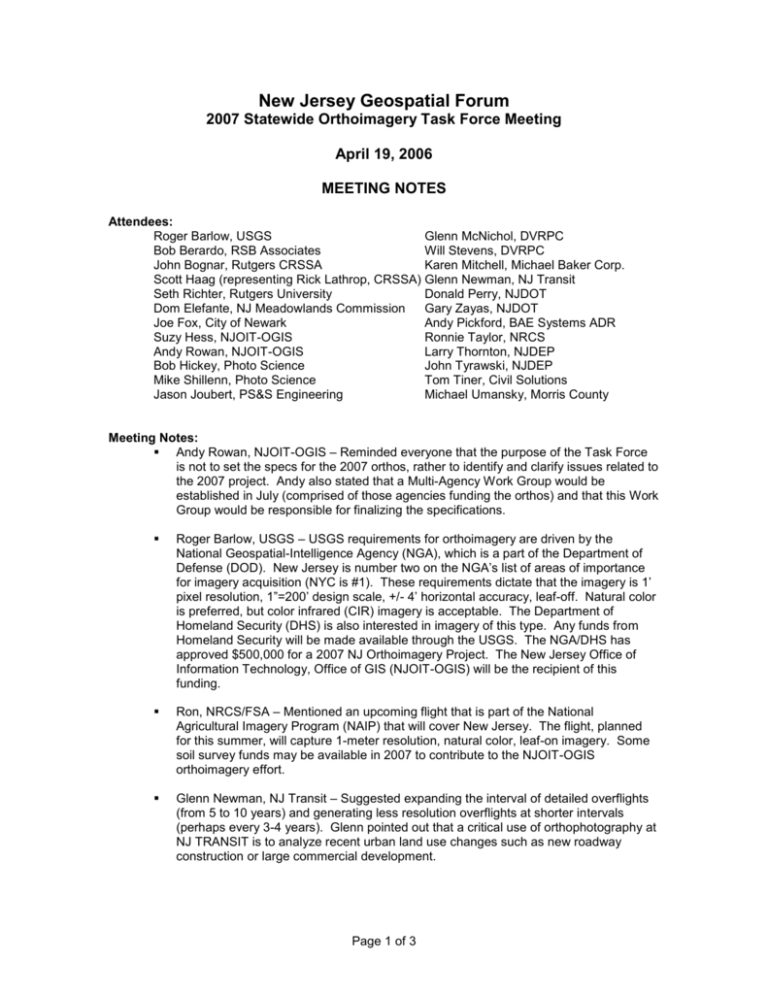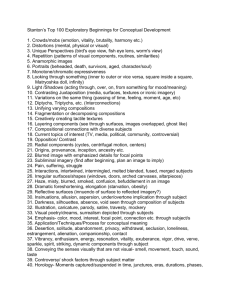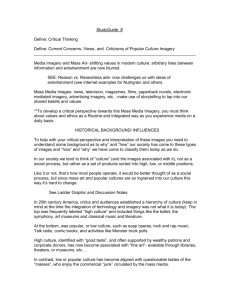Minutes - New Jersey Geographic Information Network
advertisement

New Jersey Geospatial Forum 2007 Statewide Orthoimagery Task Force Meeting April 19, 2006 MEETING NOTES Attendees: Roger Barlow, USGS Glenn McNichol, DVRPC Bob Berardo, RSB Associates Will Stevens, DVRPC John Bognar, Rutgers CRSSA Karen Mitchell, Michael Baker Corp. Scott Haag (representing Rick Lathrop, CRSSA) Glenn Newman, NJ Transit Seth Richter, Rutgers University Donald Perry, NJDOT Dom Elefante, NJ Meadowlands Commission Gary Zayas, NJDOT Joe Fox, City of Newark Andy Pickford, BAE Systems ADR Suzy Hess, NJOIT-OGIS Ronnie Taylor, NRCS Andy Rowan, NJOIT-OGIS Larry Thornton, NJDEP Bob Hickey, Photo Science John Tyrawski, NJDEP Mike Shillenn, Photo Science Tom Tiner, Civil Solutions Jason Joubert, PS&S Engineering Michael Umansky, Morris County Meeting Notes: Andy Rowan, NJOIT-OGIS – Reminded everyone that the purpose of the Task Force is not to set the specs for the 2007 orthos, rather to identify and clarify issues related to the 2007 project. Andy also stated that a Multi-Agency Work Group would be established in July (comprised of those agencies funding the orthos) and that this Work Group would be responsible for finalizing the specifications. Roger Barlow, USGS – USGS requirements for orthoimagery are driven by the National Geospatial-Intelligence Agency (NGA), which is a part of the Department of Defense (DOD). New Jersey is number two on the NGA’s list of areas of importance for imagery acquisition (NYC is #1). These requirements dictate that the imagery is 1’ pixel resolution, 1”=200’ design scale, +/- 4’ horizontal accuracy, leaf-off. Natural color is preferred, but color infrared (CIR) imagery is acceptable. The Department of Homeland Security (DHS) is also interested in imagery of this type. Any funds from Homeland Security will be made available through the USGS. The NGA/DHS has approved $500,000 for a 2007 NJ Orthoimagery Project. The New Jersey Office of Information Technology, Office of GIS (NJOIT-OGIS) will be the recipient of this funding. Ron, NRCS/FSA – Mentioned an upcoming flight that is part of the National Agricultural Imagery Program (NAIP) that will cover New Jersey. The flight, planned for this summer, will capture 1-meter resolution, natural color, leaf-on imagery. Some soil survey funds may be available in 2007 to contribute to the NJOIT-OGIS orthoimagery effort. Glenn Newman, NJ Transit – Suggested expanding the interval of detailed overflights (from 5 to 10 years) and generating less resolution overflights at shorter intervals (perhaps every 3-4 years). Glenn pointed out that a critical use of orthophotography at NJ TRANSIT is to analyze recent urban land use changes such as new roadway construction or large commercial development. Page 1 of 3 2007 Statewide Orthoimagery Task Force April 19, 2006 Meeting Notes continued… Roger Barlow suggested that Glenn Newman consider the NAIP imagery as an alternative, since NAIP is 1-meter resolution and is on a 3-year update cycle in NJ. Andy Rowan mentioned NSGIC’s proposed "Imagery for the Nation" program and described its preliminary specifications to the Task Force. He went on to state that the absolute earliest this program could get underway would be 2008, although there is no definite timeframe as yet. Gary Zayas, NJDOT – Related that NJDOT is getting short on funds. In light of this fact, any NJDOT funds transfer should be completed sooner, rather than later. Larry Thornton, NJDEP – Stated that DEP is out of money. Andy Rowan mentioned the availability of E911 funds that have been included in the 2007 budget from the 2006 budget. Scheduled presentation titled, “New Jersey 2007 Statewide Orthoimagery: Preliminary Plans”, was not made due to technical difficulties. A majority of the meeting’s attendees had already seen this presentation at the February 10, 2006 NJ Geospatial Forum meeting. Suzy Hess, NJOIT-OGIS – Reiterated that Task Force members must be sure to register on the NJGIN website to be included on the list of participants for future meetings. Suzy Hess distributed a list of “Major Issues” that should be explored with regard to the 2007 project. Andy Rowan described the preliminary specifications for the 2007 project, which are very similar to the 2002 project’s specifications. The State plans to acquire both natural color and CIR imagery, using a digital sensor. No obliques, planimetric data, or topographic contours will be included as part of this effort. Bob Hickey, Photo Science – Touched on the subject of using elevation data from different sources to enhance and/or create the 2007 ortho DEM. Will Stevens, DVRPC – Offered DVRPC’s 2005 ortho DEM for use by the State. Suzy Hess asked Bob Hickey and Mike Schillen to look into the issue of compiling an ortho DEM from different existing sources. Suzy Hess indicated that there are some issues with artifacts from large format digital camera sensors. She asked Glenn McNichol to detail some artifact problems that have been identified in DVRPC’s 2005 imagery. Glenn McNichol, DVRPC – Related that a Leica ADS40 digital sensor was used to acquire the imagery for DVRPC’s 2005 project. He explained that there were some areas of sub par image quality, marked by the prevalence of “green pixels” throughout the image. Mike Shillenn, Photo Science – Contrasted Glenn’s statements by noting that there are image quality issues with scanned, film-based products, as well. Bob Hickey described the Leica ADS40 vs. Zeiss DMC sensor with regard to how they capture imagery. He went on talk about the Vexcel UltraCam, which is similar to the Zeiss DMC in that it is a frame-based sensor, noting that it has a smaller “footprint” Page 2of 3 2007 Statewide Orthoimagery Task Force April 19, 2006 Meeting Notes continued… than the DMC. This smaller footprint would necessitate more exposures and flightlines to cover the same area. Larry Thornton said that DEP needs a way to determine flight information for legal purposes. 9x9” contact prints have been utilized for this in the past, but if the State transitions to a fully digital product in 2007 what could be used to derive this information? Bob Hickey noted that the all interested parties should examine their respective workflows to determine the viability of certain imagery acquisition methods. Bob Hickey discussed the fact that the DMC collects 12 bit data, as opposed to 8 bit. The use of 12 bit data may aid in feature extraction in areas of shadow. It was noted that 12 bit data is not yet compatible with all applications. Suzy Hess distributed a sheet (developed with the help of Photo Science) that detailed imagery storage requirements for the entire State, by county, based on different pixel resolutions, in uncompressed and compressed formats. Building lean issues were discussed. Glenn McNichol talked about the “true ortho” area of DVRPC’s project. He related that although the true ortho area is more ascetically pleasing, street-level features are still obscured by shadows. Sun angle issues were discussed. Mike Shillenn quoted the 2002 project’s specifications as being 30 degrees of sun angle or less. He also mentioned that the less sun angle allowed effectively shortens your flight season. Larry Thornton remarked that a 40+ degree sun angle in the Highlands area was beneficial in certain ways. Suzy asked Larry to explore and report back on DEP’s sun angle requirements. Bridge distortion issues were discussed. Glenn McNichol of DVRPC noted that he observed less bridge distortion and building lean issues with their ADS40-derived imagery than with the film-based imagery from their 2000 flight. Delivery time frame issues were discussed. Delivery time frame was viewed as a “process driven” aspect of the project. It was noted that multi-resolution products tend to slow down delivery. Counties were felt to be the smallest political unit that is normally dealt with in terms of “buy up” options, etc. It was stated that the Orthoimagery Task Force’s ultimate goal was to produce a report, which will be used as a guide, to assist the Multi-Agency Work Group that will be established in July. Mike Shillenn inquired about the structure of this report. Suzy Hess stated that she would assume responsibility for formatting the report. Suzy also suggested that the Task Force try to produce a draft report for the June 2nd Geospatial Forum meeting. (Meeting Notes prepared by Glenn McNichol (DVRPC), edited by Suzy Hess (NJOIT-OGIS) Page 3of 3






